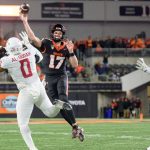Tim Walz looked the other way when leftist rioters torched the Twin Cities in the George Floyd riots.
On Tuesday morning the Democrat Party elites announced the white bread Governor Tim Walz was selected as Kamala Harris’s running mate.
Why Tim Walz? Well, the answer is obvious. Walz has a record that is remarkably to the left of even Kamala Harris.
Tim Walz was one of the worst, most restrictive governors during the COVID years.
Walz oversaw the worst Covid fraud in America. Minnesota Somali’s stole $250 million in government money and he covered for them. No one fired. But that’s not all. Walz covered for the Somali’s in the recent autism fraud scandal, then there was the Somali daycare fraud scandal. No one was ever fired.
Minnesota was number one nation for education. Now, Under Walz less than half of MN kids can read or do math at grade level. Minnesota Democrats and Walz mandated “ethnic studies” for every kid. That’s the Marxist dialectic. The state also removes your child from your care if you disagree with transgender diagnosis.
Here is a dossier on Walz provided to The Gateway Pundit from an anonymous political source in Minnesota.
The 2023 legislative session has proven to be one of the most consequential in recent history. Democrats have a one-seat majority in the Senate and a six-seat majority in the House, along with the governorship. Legislation was pushed through quickly with little ability by Republicans to block it.
In addition, the DFL employed deceptive tactics with their majorities. Numerous times they would take part in what the American Experiment labeled “legislative skullduggery,” a practice where DFL members would vote (sometimes unanimously) for a Republican amendment to a bill and then remove that amendment in the conference committee for the final bill. This would allow them to avoid unpopular votes but still get the desired end result.
Even before the current session’s slate of bills passed, it was found that over 19,000 Minnesota residents moved to other states from mid-2021-2022. Minnesota is also only one of 13 states not to have recovered its pre-pandemic levels of employment.
The current session has the potential to exacerbate these issues and drive even more people away as they seek other, more friendly states for conservatives. In many instances, the full impact of the new mandates and taxes are yet to be realized.
Many in the mainstream media have praised the actions of the legislature and some DFL lawmakers have called this session the “Minnesota Miracle.” Governor Tim Walz said these bills will have a “generational impact.” NBC News called the current session a “laboratory in pushing progressive policy.”
Over 70 bills were passed, some in quick succession, and most of the controversial bills with little or no bipartisan support. Despite narrow majorities, particularly in the state Senate, conference committees included large numbers of DFL members and small numbers of Republicans.
Unfortunately, the left is just getting started: Next session, the “Queer Caucus” has pledged to introduce the Gender Affirming Rights Act, to constitutionally enshrine the right to gender-affirming care and remove any health care regulations against it. They also want to push for mandatory comprehensive sex ed in all schools, which would unquestionably introduce content not appropriate for all ages.
Below is a topical summary of some of the major legislation and noteworthy policies enacted from the 2023 legislative session and approved by Governor Waltz.
Abortion:
Protect Reproduction Options (PRO) Act:
Establishes a fundamental right to reproductive health care (abortion) at any stage of pregnancy, with no age restrictions.
This was rushed through in the first month of the session.
Reproductive Healthcare Bill (HF366):
Makes Minnesota an abortion sanctuary.
Any doctor or nurse who assisted in an abortion, even if illegally, cannot be barred from licensure in Minnesota based on those grounds alone.
Minnesota will not honor subpoenas, record requests, or extradition requests related to performed abortion services from states where the practice can lead to civil or criminal charges.
Individuals against whom a judgment was rendered in another state related to abortion services can now countersue that individual/institution for damages equal to the judgment rendered, including attorney fees.
Health and Human Services Omnibus Bill:
Removed language requiring doctors to keep an infant alive after a failed abortion. The language was changed from requiring doctors and nurses to preserve the life of the infant to the requirement to “care for the infant who is born alive.”
Broadened reproductive health care coverage and requires medical assistance to cover abortions (i.e. covered by taxpayers). Previously, there were stipulations for medical assistance covering abortions, such as the health of the mother being in jeopardy, etc. It also increases payments for abortion services.
Removed informed consent and the 24-hour waiting period.
Abortions can now be performed at birth centers.
Removed reporting requirements on the number of infants born alive after a failed abortion, including what medical care was given.
Removed some reporting requirements for performed abortions, such as the age of the child, the reason for the abortion, and the method used, among others.
Ended the Positive Alternatives grant program, effectively removing state funding for pro-life pregnancy centers.
Budget/Taxation
The biennial budget is increasing from $52 billion to $72 billion, an increase of nearly 40%.
From the $17 billion surplus, Minnesotans who are single tax filers will only get $260, joint filers will get $520, and $260 will be given for each child, up to $1,300 total. Income limits apply to the benefit.
Provides a $1,750 tax credit per child for households making $35,000 per year, phasing out at a household income of $96,250.
Renter income tax credit.
The infrastructure bill that passed is the largest in state history.
Billions of dollars in new revenue will be needed, with some estimates stating that the various bills will create $8-10 billion in new taxes over the next four years.
Some of the taxes and increases include:
Increased taxes on vehicle purchases.
Increased vehicle registration fees.
A new fee for delivered retail purchases over $100. No explanation on how they’ll separate out if there are groceries or food in the purchase.
The gas tax is now tied to inflation.
Corporate tax increases mean Minnesota will have some of the highest in the country.
House members, however, will receive a $3,500 salary bump.
$65 million is given to the Dept. of Administration to establish equity grants and a new Office of Enterprise Management & Sustainability.
An $11 million increase for the Governor’s Office.
The passage of many of the programs during the session will require hundreds and possibly thousands of new state employees to implement and run them, causing additional costs.
Education:
Free School Lunches Bill:
Establishes the Free School Meals Program, which provides breakfast and lunch free of charge to students.
This program is not dependent on income; all students can get free meals regardless of household ability to pay.
It is estimated to cost $388 million over the next two years.
Education Omnibus Bill:
Increases spending on K-12 by over 10%, for a total budget of $23.2 billion.
This bill contains several noteworthy features:
The per pupil formula is now tied to inflation beginning in 2026, with a minimum of 2% increase and maximum 3% increase. In 2024, funding per pupil will increase by 4%, followed by a 2% increase in 2025.
Removes legislative oversight of Minnesota’s K-12 academic standards.
School districts, including charter schools, must provide free menstrual products in all bathrooms (including boy’s bathrooms).
School districts can vote to extend a school tax levy that was previously approved by voter referendum. The extension would be for the same duration and tax amount as the original (i.e. a 10-year levy could be extended by 10 years).
Schools will now have to offer an ethnic studies course. The focus, in part, must include how race and racism have and continue to be potent societal forces, including among protected classes (e.g., how whites continue to reinforce racism to protect their power). “Antiracism” is also a component to be included.
Minnesota school boards must have on their curriculum advisory committees those who are able to recommend ways to adopt “antiracist, and culturally sustaining” curriculum.
Hourly workers must be paid unemployment by school districts during summer months. Instead of getting jobs in the summer, they’ll now collect unemployment. This is the first state to enact such a program.
Some alternative pathways for acquiring teaching licenses have been restricted. This is a win for Educate Minnesota, which has fought for this change since the alternate pathways were created in 2017. Approximately 800 teachers gained licenses from the now-restricted pathways.
Created a new department, the Department of Children, Youth and Families, to implement and oversee some of these programs.
Colleges or universities that require a statement of faith are now barred from the Post Secondary Enrollment Options program. This is currently being challenged in court and the Walz administration has said they will pause enforcement of this provision.
K-3 students can no longer be suspended, except in extreme cases.
The Minnesota DOE will have to create an Ethnic Studies Working Group, with the education commissioner being required to seek input from the Minnesota Ethnic Studies Coalition, a left-wing group. The parent organization of this group calls for defunding the police and for the implementation of a new social order.
Columbus Day will be replaced with Indigenous Peoples’ Day.
Lots of these are essentially unfunded mandates that will require new staff and resources, some of which do not have adequate compensation from the state.
On a positive note, evidence-based reading strategies must be adopted. In order to graduate high school, students must now take a civics and personal finance class.
Higher Ed Omnibus Bill:
Equals nearly 7% of the total budget and includes several loan forgiveness and repayment funds in various fields.
Some noteworthy aspects of this bill:
The North Star Promise program would provide free college for students in homes with incomes below $80,000, provided they attend a Minnesota State College system school or public community college. This is expected to cost nearly $120 million to get off the ground and then $50 million per year after that. Illegal immigrants are allowed to take part in the program.
Provides a $150 million funding increase for state colleges not to raise tuition.
Elections:
Democracy for the People Act:
Signed into law with 0 Republican votes in the House or Senate. This broke the governor’s 2019 pledge to only sign bipartisan election legislation into law.
Minnesota already has high voter turnout, including at least 76% or higher turnout in presidential elections since 2004. In 2020, turnout was at 79%.
This bill contains several noteworthy features:
Requires automatic voter registration for those qualified to vote when those individuals apply for benefits, driver’s licenses, MinnesotaCare, etc. and the application requires proof of citizenship or citizenship has previously been established.
The bill also states that automatic voter registration cannot commence until various state agencies determine the technical infrastructure is working properly and doesn’t register those whose citizenship has not been confirmed. However, the bill also requires that this system be in place by December 1, 2023. What happens if the systems aren’t working correctly by that time? (i.e. when non-citizens can get driver’s licenses).
Allows voters to be added to a permanent, no-excuse absentee voter list.
Allows 16 and 17 year olds to register to vote. They will also be part of the automatic registration process if they apply for driver’s licenses.
Curiously, a provision was removed that prevented absentee voter lists from becoming public until after election day. Starting in June 2024, permanent absentee voters and absentee applicants become public.
Language minority districts will be determined before each election if 3% or more of an area speaks English less than very well. Voting materials must be distributed in that district’s applicable languages. In some cases, interpreters are also required.
Prevents the “intimidation” or transmission of information that impedes individuals from voting. In addition, the person transmitting the information can still be charged even if impeding others from voting was not the intent. Given how vague the language is, this could potentially be applied to questioning election integrity.
Prevents “foreign-influenced” corporations from contributing any money to election causes. The threshold is so low for what constitutes “foreign-influenced” that it would shut out many big businesses. Labor unions, a major DFL donor base, have no new restrictions.
During a hearing on the bill, the Minnesota Secretary of State estimated that the changes in this bill could add around 450,000 new voters to the rolls.
Many provisions go into effect in 2023 and 2024, right before the presidential election.
Felon Voting Rights Restored:
Felons on probation or parole will now become eligible to vote.
The state is required to provide these individuals with a voter registration application.
Expected to allow 55,000 more individuals the ability to register, many of whom will most likely vote DFL based on prior-felon voting studies.
Elections Omnibus Bill:
Established Minnesota as part of the National Popular Vote Interstate Compact. The compact now only needs the equivalent of states with 65 electoral votes to also join for the national popular vote to go into effect in these states. The NPVIC would essentially take away the rights of Minnesotans to determine who their presidential electors go toward.
Creates a task force to study ranked-choice voting. Originally, a shift to statewide ranked-choice voting was part of the bill, but this was stopped due to perceived problems with implementation. The compromise was the task force, so it will undoubtedly resurface as an issue in the future. This push for ranked-choice also has out-of-state megadonors, including a former Enron executive.
Changes major party definitions so that among other requirements, only parties that earned at least 8% of the vote in a presidential or senate election can claim major party status (up from 5%).
Colleges and universities are required to provide voter registration forms in the fall and spring semesters of each year.
School districts are also required to make voter registration forms available to students who will be 18 by the next election and must consult with the student body government of each school on how to best distribute these forms.
Schools must then report to the secretary of state their voter engagement plan, including what methods worked best. Afterwards, the secretary of state will report to legislative leaders on these findings. Since younger students overwhelmingly vote DFL, this is essentially a state-enforced GOTV plan for the DFL.
Allows for the setup of temporary voting locations with times that differ from what is otherwise required.
Expands early voting up to 18 days before an election.
Requires public lists of voters with accepted and rejected absentee ballots, including ballot delivery method for accepted ballots. A public list of anyone who voted early must also be kept.
Allows in certain circumstances the electronic transmission of ballots to individuals, who must then print off and mail back the completed ballot. Emailing ballots to print and send back opens the door to major election integrity issues.
Judges are age-limited at 70. They cannot run if they’ll be 70 on the first Monday of the year they’d take office. This could be to give room for younger, more liberal justices to be appointed.
Removes limits for how many times someone can assist others with marking ballots, should the voter request assistance. Previously, an individual could only assist up to three voters per election.
Energy/Environment
Carbon-Free by 2040 Bill (aka the Blackout Bill)
This bill contains several noteworthy features:
Requires that 100% of electricity sold by utilities in Minnesota must come from carbon-free sources. It includes a phase-in, with 80% of electricity coming from carbon-free sources by 2030 and 90% by 2035.
By 2035, 55% of the electricity generated from non-carbon sources must also be from renewable sources. Nuclear power does not count as renewable.
There are supposed off-ramps in the bill, but they aren’t clearly defined. The Public Utilities Commission will determine if a company can delay the required benchmarks due to how affordable and reliable the transition is going. However, the PUC also has to factor in whether the long term effects of delay are balanced. In terms of affordability, the PUC could easily argue that climate change is so urgent that current costs do not outweigh the future costs of a warming planet.
The PUC can require public utilities that use coal-fired plants to only operate during June-August and December-February, and create a cap on annual carbon dioxide emissions for those plants.
By some estimates, energy costs would increase around $3,800 per year.
New renewable energy projects take an average of five years to get approved, and often the infrastructure isn’t there to support the addition of renewable energy to the grid–not to mention how generation and storage is inefficient.
Currently, around 50% of Minnesota’s electricity is produced from coal and natural gas, meaning half the energy needs of the state will need to be found elsewhere.
In the “Wind Belt” area of the state, a lack of sufficient transmission lines has led to difficulty in getting the electricity to other areas of the state. If the electricity can’t be sent, the turbines are shut off even when the wind is blowing. Issues like these will be multiplied with the renewal energy mandates.
Some Minnesota farmers have been approached by companies who want to lease prime farmland to build solar panels. To meet the mandates of the bill, agricultural land will most likely need to be converted to solar farms at a time when many crops throughout the country are experiencing low yields. This will further increase food prices and constrict supply.
Even supporters of the bill, such as Chris Clark of Xcel, have said getting to 100% carbon-free will be a “challenge.”
The Brookings Institution found that wind power costs on average 50% more per kilowatt hour and solar 200% more per kilowatt hour than fossil fuels.
Environment, Natural Resources, Climate, and Energy Finance and Policy Bill:
Increases spending in this area by over $650 million.
Over $300+ million is geared toward renewable energy subsidies and the transition to renewables, including electric vehicle rebates ($17.5 million), an electric school bus grant program ($14 million), and the creation of the Minnesota Climate Finance Authority ($20 million).
Establishes new state emission benchmarks for greenhouse gasses, including a 50% reduction by 2030 and net-zero by 2050.
State agencies, when purchasing fleet vehicles, must prioritize the purchase of electric vehicles.
Establishes environmental justice areas in places where at least 40% of the population is non-white, and either 35% of households are at least 200% below the poverty line or 40% of the population does not have English proficiency. Policy impacts on these environmental justice areas must be taken into consideration in some instances.
The commissioner must establish a maximum for the global warming potential for each item used in the construction of buildings (i.e. how the production of materials used contribute to global warming).
The commissioner must also set up an energy benchmarking plan that would make visible how much energy commercial buildings use, which would subsequently be published online. This would apply to buildings 50,000 square feet or larger. One of the outcomes, admitted to by the bill’s author, is that it could lead to citizens/organizations pressuring these businesses about their energy usage to cause them to lower that usage.
To cover these costs, the bill raises fees on things like fishing, boating, and park passes.
Omnibus Jobs, Economic Development, Labor, and Industry appropriations:
Commercial buildings must reduce net energy consumption by 80% or greater by 2036. These codes will have mandatory benchmarks established by the commissioner of commerce.
Requires using the ASHRAE 90.1 efficiency standards guidelines.
Each new building must have a minimum number of electric vehicle charging spaces nearby, including apartment complexes and multifamily residences with more than four units.
Entitlements:
Paid Family and Medical Leave Act
Allows individuals up to 12 weeks of paid leave for a single or family medical event, or up to 20 weeks if multiple events. It does not have to be used concurrently.
An example from the Minnesota Employment and Economic Development website said that multiple events could include medical leave while recovering from pregnancy and then a second event related to family bonding with the newborn.
It can also apply to those caring for family members facing a serious illness.
Requires a 0.7% payroll tax increase, with 0.35% contributed by the employee and 0.35% by the employer.
It is estimated that 400 new government employees will need to be hired to run the program.
A $650 million one-time appropriation will help get the program started in time for its launch in 2026.
Business leaders complained they were not consulted about the ramifications of the bill.
Smaller businesses could feel greater effects of the bill if essential personnel are away on leave for long amounts of time. They aren’t given an exemption in the bill.
School districts have also stated their concerns and its impact on employee availability.
Earned Sick and Safe Time:
Employers are required to give at least one hour of sick and safe leave for every 30 hours worked, up to 48 hours regardless of the employee’s full time or part time status. A total of 80 hours could be carried over from year to year.
Public Option Healthcare:
The legislature passed a provision to study expanding MinnesotaCare and removing income limits.
Lawful immigration status was removed as a requirement for accessing MinnesotaCare, meaning illegal immigrants can now qualify.
Social Security Tax:
Single tax filers making up to $78,000 and joint filers earning up to $100,000 per year will no longer pay state Social Security taxes.
The exemption will phase out completely at $118,000 for individuals and $140,000 for couples.
LGBTQ
Trans Refuge Bill:
Makes Minnesota a “refuge” for children seeking gender-affirming treatment.
Allows the state to take temporary emergency jurisdiction of a child who is not able to obtain gender-affirming treatment, such as when the parents do not condone such treatment.
Allows the state to take temporary emergency custody of minors who travel to Minnesota to receive gender-affirming treatment.
Bars the enforcement of subpoenas and extradition requests from other states when the request is related to the requesting state’s prohibition on gender-affirming treatment.
Bars the removal of a child from the custody of a parent/guardian if the reason is due to providing gender-affirming treatment.
Conversion Therapy Ban:
Prohibits counselors from engaging in conversion therapy for minors and for vulnerable adults.
Those found in violation can face retaliation from the respective state licensing board.
Prohibits the advertising of conversion therapy services or any verbiage that makes same-sex attraction seem aberrant.
Take Pride Act:
Prohibits non-religious non-profits that serve minors from discriminating against employees who are gay or transgender. This includes organizations like the Girl Scouts, who would potentially be forced to hire or allow to volunteer biological men who identify as women.
Protected Classes:
A provision in the public safety omnibus bill removes language stating that adults attracted to children are not a protected class in the Minnesota constitution. Pedophiles may now potentially be considered a protected class should an activist judge decide to “read” that right into the state constitution. The language was removed in conference committee despite the House passing a provision 126-0 stating pedophilia is not a protected class.
In the same bill, gender identity, sexual orientation, and gender expression are now added to the list of protected classes and can lead to higher sentencing if it’s perceived a crime was committed due to someone’s identification with these classes.
Marijuana:
Marijuana Legalization Bill:
Any individual 21 years or older may possess up to two pounds of marijuana at home and two ounces in public. Two pounds is far greater than any other state allows, even California.
Establishes the Office of Cannabis Management, with nearly $80 million to assist in the development of regulation mechanisms.
Includes a 10% sales tax on marijuana products.
Expunges the records of those with misdemeanor marijuana offenses.
Creates licensing types for various stages of production.
Distribution licenses will be granted in part through social equity scores.
It funds cannabis abuse programs to teach others of the dangers of addiction.
It creates grants for those entering the legal cannabis market.
No current test exists to confirm marijuana intoxication on the road if pulled over by police.
Goes into effect on August 1, 2023, despite many of the regulations not yet ready for implementation.
Public Safety:
Driver’s Licenses for All Bill:
When individuals apply for a driver’s license, they will no longer need to verify citizenship or permanent residence, meaning illegal immigrants can now receive driver’s licenses.
An estimated 80,000 individuals will be eligible due to this new law.
One of the main concerns with this change is it has the potential, if not implemented correctly, to automatically register these individuals to vote.
Public Safety Omnibus:
Some of the noteworthy features of this bill:
Universal background checks required for the transfer of pistols and assault rifles, even in non-business transactions (including giving as gifts).
Establishes an Extreme Risk Protection Order (ERPO), or red flag law, for individuals deemed to be at risk of harming themselves or others. The law can require the confiscation of any firearms in the individual’s possession and this confiscation can be decided without the individual present. The individual would also have to wait at least six months before possessing firearms again.
A Human Rights provision will allow the legislature to decrease judges’ sentences.
A hate speech database will be created, where people and organizations can report hate speech to the Dept. of Human Rights, even if the speech is not illegal.
An Office of Restorative Practices is created. The purpose of this office will be to implement alternatives to jail for juveniles who are convicted of committing serious crimes.
No-knock search warrants are effectively banned.
Minnesota Rehabilitation and Reinvestment Act: This would seek to get inmates to join rehabilitation programs while incarcerated, allowing some to earn a 50% reduction in their sentences.
The DFL killed an amendment seeking to make it harder for sex offenders to live near daycares.
While this is just a highlight of some of the major legislation that has passed, several major spending bills were approved at the last minute and most likely include provisions that were deliberately concealed to avoid exposure until after the bill passed. It remains to be seen what, if any, these provisions include.
The post Why Did Kamala Handlers Pick Gov. Walz? — Here’s a Close Look at His Radical Policies That Places Him to the Left of Kamala Harris appeared first on The Gateway Pundit.







